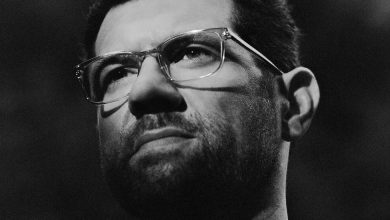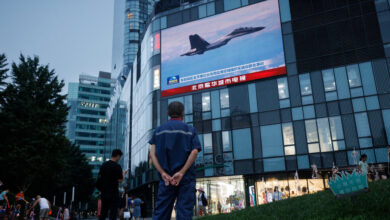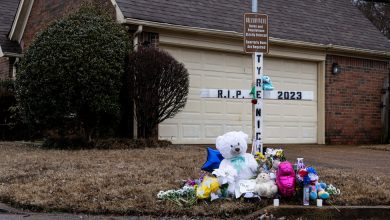In a Time of Crisis, a City Fights Isolation

FROME, England — For more than a thousand years this market city was best known for products made from wool and woven fabrics and later for its large iron statues, including the Lady Justice figure that still sits atop the dome of the Old Bailey court about 100 miles east in London.
But these days, Frome (pronounced FROOM) has been getting attention for something far more unusual and urgent: Its fight against loneliness.
Frome’s approach to the global human affliction began as an experiment by a local physician, Dr. Helen Kingston, eight years ago. It caught the attention of publications of all kinds, including this one, and has been studied and replicated by countries around the world. The urgency has only been exacerbated by the raging pandemic.
The work by Dr. Kingston and her team was first recognized by then Prime Minister Theresa May — who appointed a member of Parliament, Tracey Crouch, as the first minister for loneliness in 2018. But the Frome Model, as it is known, reached a milestone just a few weeks ago when the National Health Service (N.H.S.) in Britain, locked in permanent funding for the program after years of patchwork financial support.

The town’s approach to fighting loneliness began as an experiment by a local physician, Dr. Helen Kingston, eight years ago. Credit…James Beck for The New York Times
The efforts haven’t ended at Frome. In November, the government of Victoria, Australia, agreed to create the position and Japan added one in February amid rising suicide rates. And cities around Britain and as far away as Sweden and Colombia are studying Frome’s experience and hoping to copy its success in reducing emergency hospital admissions, an achievement that is gold dust in a time of rising health costs.
So why Frome? And what was so special about its approach?
The effort begun here is based on a model of health care driven by the local medical clinic, the Frome Medical Practice, that seeks to improve the emotional well-being of patients by tapping into community connections and volunteer groups to help people deal with such problems as loneliness and social isolation, which are not usually viewed as medical problems.
“If this was a franchise it would be a very attractive one to sell,” said Will Palmer, a 59-year-old fashion industry consultant who helps British brands enter foreign markets. Mr. Palmer doubles as one of Frome’s “health connectors,” who link people to community groups and services ranging from home heating advice to help with hearing aids and cooking lessons.
One of the most striking things about the Frome idea is that apart from eight paid connectors like Mr. Palmer, this city of just under 30,000 has also trained 1,140 voluntary “community connectors.” Cafe owners, taxi drivers and other ordinary residents have been taught how to advise their friends and neighbors about the community groups and services that often go underused for the simple reason that people do not know they exist.
Mr. Palmer’s specialty is getting people digitally connected. Recently he was sitting in the Cheese and Grain Cafe giving smartphone lessons to John Willis, a 77-year-old retired builder who feels his generation is being isolated by the rise of online shopping and government services.
“We are being left behind,” Mr. Willis said. “Everyone communicates online nowadays and you have to pay through the nose if you can’t shop online.” Mr. Willis’s digital lessons were organized through the medical practice, along with advice on how to reduce large utility bills that were worrying him after the death of his ex-wife, Eileen, 18 months ago left him depressed and anxious.
“I was on the verge of a mental breakdown and had terrible headaches and stress,” he said. “I couldn’t be bothered going out or seeing anyone but it’s hard to say you’re lonely because you are supposed to be a hard man.”
Mr. Palmer and his team of 70 volunteer “digital connectors,” who help point people toward digital training and free Wi-Fi or donated electronic devices, are just part of a vibrant network of community services that can be mobilized to deal with some of the emotional issues that often exacerbate people’s health problems.
In the parking lot outside the coffee shop, several unused toilets have been converted to a community fridge, which dispenses donated food to whoever wants it, and the Frome Coat Rack offering free jackets and other clothes.
A few meters away is the Talking Bench, a wooden seat where Hayley Morgan, health connector, and Janet Copsey, a volunteer, wait each Wednesday morning to talk to anyone who just wants to chat or is looking for advice about the often bewildering lineup of community groups in Frome.
Ms. Copsey, 60, has been trained to advise people about everything from joining choirs and sports groups to finding tips on green lifestyles.
The Talking Bench is an offshoot of a popular Talking Café, where strangers can get together; Ms. Copsey is also involved in a postcard-writing project which sends friendly missives to people with little social contact.
Just around the corner is Share, a nonprofit “library of things” that cuts waste by lending items ranging from donated power tools to geothermal cameras for monitoring home heat- loss.
While many cities have vibrant community networks, the unusual thing about Frome’s initiative is the role of the medical practice in mobilizing them as part of a deliberate strategy to strengthen patients’ resilience and well-being.
Dr. Kingston, 56, has worked at the Frome Medical Practice for 26 years, spending much of that time frustrated that her patients often needed more than a drug. But she lacked the resources to help them with the nonmedical stresses and crises exacerbating their health problems.
In 2013, she won National Health Service funding for her practice and for the wider local government district of Mendip, with its population of 115,000, to employ Jenny Hartnoll, a dynamic community development worker who wanted to compile a guide to existing community services and to see whether there were any obvious gaps that could be filled by new groups.
“Because we’re on the edge of Somerset [county] they let us get on with things and our practice was big enough to do things at scale but not so big that you had to have a committee of 50 people making decisions when you wanted to try something new,” said Dr. Kingston.
“It’s not just lonely people who benefit from more social connections, we all have that basic human need and by recognizing that fact you can support people instead of waiting until there’s a crisis,” she added. “If the real reason you are depressed and not sleeping is that you’re bereaved or have lost your job then no pill is going to cure that but just asking people what’s on their mind helps you to formulate a better plan for them.”
The practice now employs the health connectors, who earn £20,000 to £26,000 a year ($26,450 to $34,400; some are part-time), and a team of nurses to reach out to vulnerable people who need support. The community development work led by Ms. Hartnoll means the nurses and doctors know what services are available to help each person, and the hundreds of community connectors trained by her team are spreading that information even further.
Ms. Hartnoll, 54, encouraged retired software worker Patrick Abrahams, 70, for instance, to set up a Men’s Shed, which now offers two weekly sessions where both men and women can gather to share woodworking and other projects, often repairing things for services like the Community Fridge and the local hospital.
Ron Carver, an 87-year-old retired master carpenter who is known as “El Presidente” of the shed, says he enjoys passing on his skills “but the camaraderie is what you really want.”
“A lot of us are on our own, so it’s great to get together,” said Mr. Carver, whose most recent project was a small wooden coffin for the ashes of his wife, Iris, who died in 2018.
Dr. Julian Abel, a retired palliative care consultant, said the results in Frome of fostering human relationships and a more compassionate community as a part of medical care amounted to “a medical miracle.”
It was Dr. Abel who got access to local medical data in 2018 and published a report, peer-reviewed and published by the British Journal of General Practice, showing that from 2013 to 2017, when the program was underway, emergency hospital admissions in Frome fell by 14 percent while they rose by 29 percent in the broader county of Somerset, even though the demographics are similar.
“There are no other interventions which have ever reduced population emergency admissions like this,” he said.
Ms. Hartnoll shies away from the idea that loneliness has been or could ever be eradicated and says her work has been helped by having a town council that is innovative and focused on community development.
Nonetheless, Frome’s reputation has been transformed from that of a place where it could be dangerous to go into town on a Saturday night 20 years ago to an unusually friendly and caring community, helping to attract an influx of middle-class newcomers from London and elsewhere.
One result — unhappy to some — has been a surge in home prices, prompting a backlash from some longtime residents.
Andy Wrintmore, a 6-foot 9-inch-tall drummer in a punk rock band who was elected Frome’s mayor this year, says he cannot afford to buy a house “so I can see why some ‘Old Fromies’ are not happy.”
“But I still think the changes in the community have been fantastic,” said the 29-year-old mayor.
Ms. Hartnoll is adamant that there is nothing special about Frome that suggests the model cannot succeed elsewhere. The Mendip district is ethnically homogeneous — in the 2011 census 98.7 percent of household leaders were white — but the city has enough economic problems to dispel any notion that it is some ideal community, she said.
Ms. Hartnoll’s team is struggling to keep up with international requests for information and training, work that is not covered by their N.H.S. funding and would ideally be funded by international philanthropy.
Dr. Marcello Bertotti, a senior research fellow at the University of East London, said Frome was “at the vanguard” of the growing movement to better incorporate nonclinical solutions into medical care.
“Since 2019 the N.H.S. has funded 1,470 community ‘link workers’ in medical practices around the country but Frome has been really pioneering by also having all those volunteer community connectors,” he said. “Cities all around the world are taking notice.”
Before Covid arrived, the Frome team was visited by interested groups from Hong Kong, Colombia, Italy, Australia and elsewhere, and in the past eight months it has given online advice to others from Denmark, Portugal, and Ontario and British Columbia, Canada.
Friends in Umea, a community group from the Swedish city has conducted a series of Zoom meetings with Ms. Hartnoll’s team and is working with doctors and nonprofit groups to copy some of its approach.
“We are suggesting a model similar to the one in Frome and we are on our way from theory to practice,” says Bjerre Ljungberg, one of the group’s board members.
“It feels like we are taking part in a worldwide network against loneliness,” he said.





